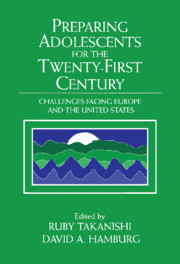Book contents
- Frontmatter
- Contents
- Contributors
- Foreword
- Preface
- 1 Meeting the essential requirements for healthy adolescent development in a transforming world
- 2 Adapting educational systems to young adolescents and new conditions
- 3 The impact of school reform for the middle grades: A longitudinal study of a network engaged in Turning Points–based comprehensive school transformation
- 4 Schooling for the middle years: Developments in Europe
- 5 The role of the school in comprehensive health promotion
- 6 Education for healthy futures: Health promotion and life skills training
- 7 HUMBIO: Stanford University's human biology curriculum for the middle grades
- 8 Education for living in pluriethnic societies
- 9 The economics of education and training in the face of changing production and employment structures
- 10 School-to-work processes in the United States
- 11 Finding common ground: Implications for policies in Europe and the United States
- Name index
- Subject index
8 - Education for living in pluriethnic societies
Published online by Cambridge University Press: 10 May 2010
- Frontmatter
- Contents
- Contributors
- Foreword
- Preface
- 1 Meeting the essential requirements for healthy adolescent development in a transforming world
- 2 Adapting educational systems to young adolescents and new conditions
- 3 The impact of school reform for the middle grades: A longitudinal study of a network engaged in Turning Points–based comprehensive school transformation
- 4 Schooling for the middle years: Developments in Europe
- 5 The role of the school in comprehensive health promotion
- 6 Education for healthy futures: Health promotion and life skills training
- 7 HUMBIO: Stanford University's human biology curriculum for the middle grades
- 8 Education for living in pluriethnic societies
- 9 The economics of education and training in the face of changing production and employment structures
- 10 School-to-work processes in the United States
- 11 Finding common ground: Implications for policies in Europe and the United States
- Name index
- Subject index
Summary
Perspective
Living in a multicultural and multiethnic society like the United States or the European Union (EU) requires dealing with multinomy, the coexistence of many, possibly divergent norms. Moreover, every culture in our contemporary complex societies is subdivided into so many subcultures and lifestyles that quite a few social scientists wonder if such a thing as a culture – a system of meaning shared by people of a given population – really does exist. The term postmodern condition is sometimes used to indicate this multinomy.
Nevertheless, Hannerz (1992) rightly states that culture remains a reality. This type of reality, however, is far removed from the uniform, monolithic systems we are accustomed to meet in the descriptions of the so-called primitive tribes by the anthropologists of generations gone by. At closer sight, every single culture appears to be internally pluralistic and unevenly distributed over social categories and groups. In the contemporary world, mass media and power relations play an important role in the dissemination and distribution of culture.
Subcultures and lifestyles are in permanent flux. A culture is not a monolithic thing, a package inherited from one' ancestors, as is often suggested in popular political discourse.
In the context of this continuous cultural flow and instability, a considerable number of political leaders and groups are struggling to maintain or create a multitude of ethnic, ethnonational, national, hypernational, and cultural identities, and are trying to express and organize these forms of auto- and hetero-identification (Hobsbawm, 1993; Moynihan, 1993; Schlesinger, 1991; Smith, 1986). Ethnicity is fashionable.
- Type
- Chapter
- Information
- Preparing Adolescents for the Twenty-First CenturyChallenges Facing Europe and the United States, pp. 151 - 176Publisher: Cambridge University PressPrint publication year: 1997



